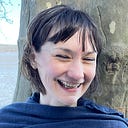Not just “Heinz 57”: Relating to a Mix of Ancestors
I used to have this idea that I was 1/4 this and 1/8 that. To some extent, it’s true: it’s many Westerners’ common way of quantifying our heritage and acknowledging where our ancestors lived, particularly given the US’s status as home to some many diasporic peoples. I thought that my “whole” was made of many parts, and I felt rather fragmented as a result. I mean, I don’t look Filipino, I don’t speak Gaelic, I didn’t know my Swedish granddad, and I haven’t been to Hungary or Germany. So am I really any of those things? What are the criteria? Am I just an American “Heinz 57” — is that its own culture? How do I connect with ancestors who weren’t American (or even white) like me?
In an effort to research and make sense of my background, I ran into the messy business of “blood quantum.” This was, and is still is in some places, a way of measuring the amount of Native American blood one possesses as a qualifier for membership to the tribe. It limits “Indianness,” and also dovetails with the contradictory “one drop rule:” for a large part of American history, if someone had any trace of Black ancestry, they were considered Black. So one might need to have 25% or more Native American blood to be considered Native, a criteria which decreased the perceived Native population. Yet, having just one drop of African blood rendered someone non-white, bolstering some idea…
